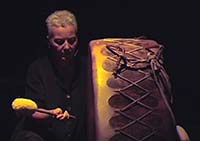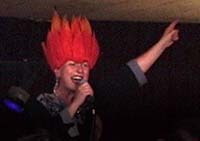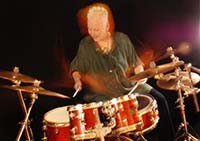 |
|||||
Surfers ride the age waveFilm seeks to break myths of aging by focusing on older legends of the "sport of kings' Dana Perrigan, Let's face it: In America's youth-oriented society, getting old is about as sexy as Freddy Krueger in drag. It is also, to some, a lot scarier. People flee its relentless pursuit - sometimes to the nearest plastic surgeon - as if were some kind of horrifying monster haunting their dreams of immortal youth. That's why Roy Earnest and David Brown - local producers of the movie "Surfing for Life" - have set themselves the goal of trying to unmask the demon. In their hourlong documentary-in-progress, they seek to shatter the stereotypes associated with aging by using one of the world's most youth-identified sports. By focusing on the lives of senior surfers, many of whom are legends in the "sport of kings," they seek to redefine what it means to grow old, to show the possibilities, as well as the challenges, of mature life. Most of all, they hope to do it in a way that won't put the audience to sleep. Showing big-wave pioneers dropping down the face of a 35-foot wave beneath the blue Hawaiian skies can't hurt. Neither can footage from some of Hollywood's now-campy surf movies and a soundtrack that includes the Mermen. "What we're trying to do is to inspire people in their own lives, to help them get rid of the negative images that they've been handed by the media and replace them with positive ones," says Earnest, the 42-year-old director of Francis of Assisi Community, a residence for the elderly on Guerrero Street. An avid surfer since the age of 8 and one of the founding members of the Pedro Point Surf Club in Pacifica, Earnest says he got the idea for the documentary after overhearing a couple of kids watching a middle-aged surfer one day. "They said something like, "He's an old guy. I'm amazed that he can even remember how to surf. Don't people forget stuff at that age?"" Earnest, who knew better, took his idea to Brown - an award-winning filmmaker whose work includes four PBS documentaries on nuclear issues. His "Bound by the Wind," a treatise on the legacy of nuclear testing, won 18 international awards. "In my field, I'm known as the nuclear issue guy," says Brown, 49. "I've focused on terrible, tragic stories about corporate greed and government deception. "Surfing for Life' was a welcome idea - fun, life-affirming." The pair rounded up some of the best talent in the surfing world to help them: Don King, director of water photography, was responsible for the action footage in "Endless Summer 2" ; Matt Warshaw, co-writer, was former editor of Surfer magazine; Deborah Hoffmann edited the Academy-award-winning documentary, "The Times of Harvey Milk." After interviewing hundreds of prospective subjects, Earnest and Brown decided on about a dozen senior surfers to drive home their point, including: John "Doc" Ball, 89, the oldest living American surfer, who started riding waves in 1929 and still surfs (without a wet suit) in Northern California's Shelter Cove. A retired dentist and photographer, he wrote "California Surfriders: 1946," now considered a classic. "They tell me all the time that I'm some kind of inspiration," says Ball from his home in Eureka. "I tell 'em I don't want to be buried until I'm dead." Leroy "Granny" Grannis, 78, is an ex-military pilot and phone company executive who's been searching for the perfect wave almost as long as Ball. A former staff photographer for Surfer magazine, Grannis took up hang-gliding in his 50s and sailboarding in his 60s. "I think it's a terrible mistake to think that just because you're over 60 you have to sit around and watch TV," says Grannis. "I may have retired from the phone company, but I haven't retired from living." Eve Fletcher, 70, an animator who worked for Disney Studios on "Sleeping Beauty" and "Cinderella," paddled out for her first wave in 1958 and has been at it ever since. Scenes from Fletcher's 1958 safari to Hawaii, when she lived in a van she bought for $25 from big-wave rider Fred Van Dyke (who is also featured in the film), is one of the highlights of the documentary. "When I was young, I tried to analyze everything," says the Laguna Beach resident. "You can't do that. You just have to let it happen. You have to go on and live life to the best of your ability." The list also includes Woody Brown, 84, inventor of the modern catamaran and a celebrated big-wave surfer during the '40s; Anona Napoleon, 56, a champion surfer in the '50s and early '60s; Rabbit Kekai, 77, the first practitioner of high-performance hot-dog surfing; Otis Chandler, 68, former publisher of the Los Angeles Times and a dedicated surfer since his boyhood; Buffalo Keaulana, 61; and John Kelly, 75. But their subjects, points out filmmaker Brown, weren't chosen just for their continued ability to carve up a nice wave. Dozens of older surfers can still do that. The surfers in the film were picked because they had in common key attributes that Brown and Earnest believe to be vital to healthy aging: Passionate involvement, exercise, a sense of humor and acceptance, loving relationships, a sense of community and of being close to nature. "The film's not suggesting that everyone surf for a healthy life," says Brown. "It's not a prescription for healthy aging. It's an expanded vision of the possibilities for all of us." Sponsored by the Film Arts Foundation and now 70 percent complete, the film is a compilation of archival surfing footage showing the legends in their element, contrasted with shots of them surfing today; historical still photos of the surf scene of yesteryear; on-camera interviews and commentaries on aging by renowned gerontologists Robert Butler (a Pulitzer Prize-winning author) and Christine Cassel. The score includes popular music from different eras - from Glenn Miller and Benny Goodman to Dick Dale and the Deltones and the Beach Boys. An original score will complement the recorded music. A final, 10-day shoot in Hawaii will provide the remaining footage needed for the film. Only editing will then remain. Shown at several benefit screenings throughout the Bay Area, the partially completed documentary has already been viewed by thousands - some of whom, says Earnest, had their own ideas about what form the final version should take. "We're getting a lot of feedback from the surfing world saying, "Hey, forget about this aging stuff and stick with the legends.' It was tempting to go that way, but we stayed with the original intent." Not that this is by any means your typical gerontology film, says Earnest, who has seen hundreds of them. "Most movies on aging are boring. People don't want to watch that. They want to avoid the whole thing because they think it's depressing. We're doing something radical ... we're trying to address a social injustice, which is basically destroying the human potential in later life." While Earnest and Brown hope seniors can get something out of their film, it was designed primarily for people in their 30s, 40s and 50s, who wonder what lies ahead for them on the road of life. They also hope their documentary, which is scheduled to be finished in October 1997, will become required viewing in gerontology classes exploring the potentials of aging. "That would be cool," says Earnest.
|
|||||
Copyright © 2019, Pulse of Peace Pictures PO Box 1424 Mill Valley, CA 94942
|
|||||




